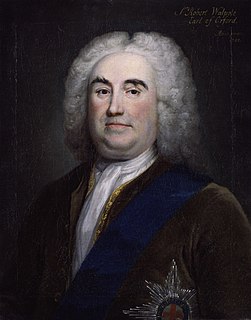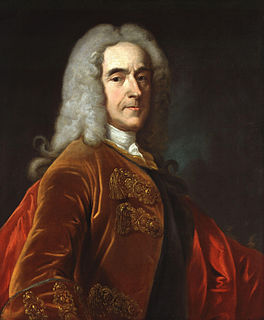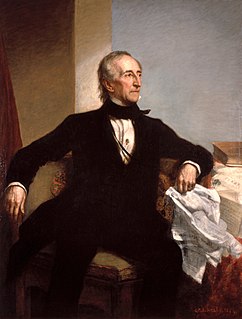
William Pitt, 1st Earl of Chatham, was a British statesman of the Whig group who served twice as Prime Minister of Great Britain in the middle of the 18th century. Historians call him Pitt of Chatham, or William Pitt the Elder, to distinguish him from his son, William Pitt the Younger, who also was a prime minister. Pitt was also known as The Great Commoner, because of his long-standing refusal to accept a title until 1766.

Robert Walpole, 1st Earl of Orford,, known between 1725 and 1742 as Sir Robert Walpole, was a British statesman who is generally regarded as the de facto first Prime Minister of Great Britain.

William Cavendish, 4th Duke of Devonshire,, styled Lord Cavendish before 1729 and Marquess of Hartington between 1729 and 1755, was a British Whig statesman and nobleman who was briefly nominal Prime Minister of Great Britain. He was the first son of William Cavendish, 3rd Duke of Devonshire and his wife, the former Catherine Hoskins.

Thomas Pelham-Holles, 1st Duke of Newcastle upon Tyne and 1st Duke of Newcastle-under-Lyme, was a British Whig statesman, whose official life extended throughout the Whig supremacy of the 18th century. He is commonly known as the Duke of Newcastle.

William Petty, 1st Marquess of Lansdowne,, known as The Earl of Shelburne between 1761 and 1784, by which title he is generally known to history, was an Irish-born British Whig statesman who was the first Home Secretary in 1782 and then Prime Minister in 1782–83 during the final months of the American War of Independence. He succeeded in securing peace with America and this feat remains his most notable legacy. He was also well known as a collector of antiquities and works of art.

Thomas Townshend, 1st Viscount Sydney PC, was a British politician who sat in the House of Commons from 1754 to 1783 when he was raised to the peerage as Baron Sydney. He held several important Cabinet posts in the second half of the 18th century. The cities of Sydney in Nova Scotia, Canada, and Sydney in New South Wales, Australia were named in his honour, in 1785 and 1788, respectively.

John Russell, 4th Duke of Bedford was an 18th-century British statesman. He was the fourth son of Wriothesley Russell, 2nd Duke of Bedford, by his wife, Elizabeth, daughter and heiress of John Howland of Streatham, Surrey. Known as Lord John Russell, he married in October 1731 Diana Spencer, daughter of Charles Spencer, 3rd Earl of Sunderland; became Duke of Bedford on his brother's death a year later; and having lost his first wife in 1735, married in April 1737 Lady Gertrude Leveson-Gower, daughter of John Leveson-Gower, 1st Earl Gower.
The Rockingham Whigs in 18th century British politics were a faction of the Whigs led by Charles Watson-Wentworth, 2nd Marquess of Rockingham, from about 1762 until his death in 1782. The Rockingham Whigs briefly held power from 1765 to 1766 and again in 1782, and otherwise were usually in opposition to the various ministries of the period.
Robert Walpole and Charles Townshend, 2nd Viscount Townshend were removed from their positions in the government, and were replaced by James Stanhope, 1st Viscount Stanhope of Mahon and Charles Spencer, 3rd Earl of Sunderland, who cooperatively led the first Stanhope–Sunderland ministry. The two Whigs remained in power from 1717 to 1721, although in 1718, Lord Stanhope exchanged positions with Lord Sunderland to form the second Stanhope–Sunderland ministry. Upon Lord Stanhope's death, Robert Walpole, widely considered the first true Prime Minister of Great Britain, returned to head the government.
The article lists the records of Prime Ministers of Great Britain and of the United Kingdom since 1721.

The Bedford Whigs were an 18th-century British political faction, led by John Russell, 4th Duke of Bedford. Other than Bedford himself, notable members included John Montagu, 4th Earl of Sandwich; Granville Leveson-Gower, 2nd Earl Gower; Richard Rigby, who served as principal Commons manager for the group; Thomas Thynne, 3rd Viscount Weymouth; Edward Thurlow; and George Spencer, 4th Duke of Marlborough
The caretaker ministry was the government of Great Britain for a short time in 1757, during the Seven Years' War.

The Cobhamite faction were an 18th-century British political faction built around Richard Temple, 1st Viscount Cobham and his supporters. Among its members, the group included the future Prime Ministers William Pitt and George Grenville. They had a general Whig philosophy and were at first supporters of Prime Minister Sir Robert Walpole but later became opponents of his administration.

This is a list of the principal holders of government office during the second premiership of the Marquess of Rockingham for four months in 1782.

The Chatham ministry was a British government led by William Pitt, 1st Earl of Chatham that ruled between 1766 and 1768. Because of Pitt's former prominence before his title, it is sometimes referred to as the Pitt ministry. Unusually for a politician considered to be Prime Minister, Pitt was not First Lord of the Treasury during the administration, but instead held the post of Lord Privy Seal.
This is a chronological list of all those who served as British prime minister and were still living at different periods in history.

The 5th Parliament of Great Britain was summoned by George I of Great Britain on 17 January 1715 and assembled on the 17 March 1715. When it was dissolved on 10 March 1722 it had been the first Parliament to be held under the Septennial Act of 1716.













